Parkia javanica Edible Pods Reveal Potential as an Anti-Diabetic Agent: UHPLC-QTOF-MS/MS-Based Chemical Profiling, In Silico, In Vitro, In Vivo, and Oxidative Stress Studies
Abstract
:1. Introduction
2. Results
2.1. Chemical Profiling
2.2. In Silico Studies of Phytochemicals
Molecular Docking
2.3. Biological Evaluation
2.3.1. In Vitro α-Glucosidase Inhibitory Assay
2.3.2. In Vivo Analysis in Swiss Albino Mice
2.3.3. Oxidative Stress Analysis
Catalase Activity Assay
MDA Assay
SOD Activity Assay
3. Discussion
4. Materials and Methods
4.1. Collection of Plant Material
4.2. UHPLC-QTOF-MS/MS
4.3. Molecular Docking
4.4. Virtual Screening
4.5. In Vitro α-Glucosidase Enzyme Inhibitory Assays
4.6. In Vivo Anti-Diabetic Activity
4.7. Blood Glucose Level Analysis
4.8. Oxidative Stress Analysis
4.9. Prediction of Physiochemical Parameters Using SwissADME
4.10. Statistical Analysis
5. Conclusions
Supplementary Materials
Author Contributions
Funding
Institutional Review Board Statement
Informed Consent Statement
Data Availability Statement
Acknowledgments
Conflicts of Interest
References
- Saeedi, P.; Petersohn, I.; Salpea, P.; Malanda, B.; Karuranga, S.; Unwin, N.; Colagiuri, S.; Guariguata, L.; Motala, A.A.; Ogurtsova, K.; et al. Global and regional diabetes prevalence estimates for 2019 and projections for 2030 and 2045: Results from the International Diabetes Federation Diabetes Atlas, 9th edition. Diabetes Res. Clin. Pract. 2019, 157, 107843. [Google Scholar] [CrossRef] [PubMed]
- Sathyanath, S.; Kundapur, R.; Deepthi, R.; Poojary, S.N.; Rai, S.; Modi, B.; Saxena, D. An economic evaluation of diabetes mellitus in India: A systematic review. Diabetes Metab. Syndr. 2022, 16, 102641. [Google Scholar] [CrossRef] [PubMed]
- Hossain, M.A.; Pervin, R. Chapter 34—Current Antidiabetic Drugs: Review of Their Efficacy and Safety. In Nutritional and Therapeutic Interventions for Diabetes and Metabolic Syndrome, 2nd ed.; Bagchi, D., Nair, S., Eds.; Academic Press: Cambridge, MA, USA, 2018; pp. 455–473. [Google Scholar]
- William, J.; John, P.; Mumtaz, M.W.; Ch, A.R.; Adnan, A.; Mukhtar, H.; Sharif, S.; Raza, S.A.; Akhtar, M.T. Antioxidant activity, α-glucosidase inhibition and phytochemical profiling of Hyophorbe lagenicaulis leaf extracts. Peer J. 2019, 7, e7022. [Google Scholar] [CrossRef] [PubMed]
- Dirir, A.M.; Daou, M.; Yousef, A.F.; Yousef, L.F. A review of alpha-glucosidase inhibitors from plants as potential candidates for the treatment of type-2 diabetes. Phytochem. Rev. 2022, 21, 1049–1079. [Google Scholar] [CrossRef] [PubMed]
- Hasimun, P.; Adnyana, I.K. Zingiberaceae family effects on alpha-glucosidase activity: Implication for diabetes. In Bioactive Food as Dietary Interventions for Diabetes; Academic Press: Cambridge, MA, USA, 2019; pp. 387–393. [Google Scholar] [CrossRef]
- Shikov, A.N.; Narkevich, I.A.; Akamova, A.V.; Nemyatykh, O.D.; Flisyuk, E.V.; Luzhanin, V.G.; Povydysh, M.N.; Mikhailova, I.V.; Pozharitskaya, O.N. Medical species used in Russia for the management of diabetes and related disorders. Front. Pharmacol. 2021, 12, 697411. [Google Scholar] [CrossRef] [PubMed]
- Chattopadhyay, K.; Wang, H.; Kaur, J.; Nalbant, G.; Almaqhawi, A.; Kundakci, B.; Panniyammakal, J.; Heinrich, M.; Lewis, S.A.; Greenfield, S.M.; et al. Effectiveness and safety of ayurvedic medicines in type 2 diabetes mellitus management: A systematic review and meta-analysis. Front. Pharmacol. 2022, 13, 821810. [Google Scholar] [CrossRef] [PubMed]
- Sun, G.; Li, C.; Cui, W.; Guo, Q.; Dong, C.; Zou, H.; Liu, S.; Dong, W.; Miao, L. Review of herbal traditional chinese medicine for the treatment of diabetic nephropathy. J. Diabetes Res. 2016, 2016, 5749857. [Google Scholar] [CrossRef]
- Yuzo, S.; Tomoko, U.; Khookhor, O.; Tatsuro, K.; Tatsuo, T.; Qin, B. Role of herbal medicine (Kampo formulations) on the prevention and treatment of diabetes and diabetic complications. J. Tradit. Med. 2006, 23, 185–195. [Google Scholar]
- Kanwal, S.; Ahmad, S.; Yasmin Begum, M.; Siddiqua, A.; Rao, H.; Ghalloo, B.A.; Shahzad, M.N.; Ahmad, I.; Khan, K.U. Chemical Profiling, in-vitro biological evaluation and molecular docking studies of Ruellia tweediana: An unexplored plant. Saudi Pharm. J. 2024, 32, 101939. [Google Scholar] [CrossRef]
- Nahar, N.; Nazmul Hasan, Z.M.; Biswas, P.; Morsaline, B.M.; Bibi, S.; Albekairi, N.A.; Alshammari, A.; Nazmul Hasan, M. Profiling of secondary metabolite and evaluation of anti-diabetic potency of Crotalaria quinquefolia (L): In-vitro, in-vivo, and in-silico approaches. Saudi Pharm. J. 2024, 32, 101887. [Google Scholar] [CrossRef]
- Ayoola, M.D.; Ogundeko, Y.B.; Obanleowo, T.D.; Omole, D.O.; Chukwu, B.N.; Faloye, K.O. Evaluation of the antidiabetic activities of the fruit of Parquetina nigrescens (Afzel.) bullock and in silico identification of its antidiabetic agent. Bioinform. Biol. Insights 2024, 18, 1–10. [Google Scholar] [CrossRef] [PubMed]
- Akinyede, K.A.; Oyewusi, H.A.; Hughes, G.D.; Ekpo, O.E.; Oguntibeju, O.O. In vitro evaluation of the anti-diabetic potential of aqueous acetone Helichrysum petiolare extract (AAHPE) with molecular docking relevance in diabetes mellitus. Molecules 2022, 27, 155. [Google Scholar] [CrossRef] [PubMed]
- Chang, C.L.; Lin, Y.S.; Bartolome, A.P.; Chen, Y.C.; Chiu, S.C.; Yang, W.C. Herbal therapies for type 2 diabetes mellitus: Chemistry, biology, and potential application of selected plants and compounds. Evid. Based Complement Alternat Med. 2013, 2013, 378657. [Google Scholar] [CrossRef] [PubMed]
- Salehi, B.; Ata, A.; Nanjangud, V.A.K.; Sharopov, F.; Ramírez-Alarcón, K.; Ruiz-Ortega, A.; Ayatollahi, S.A.; Fokou, P.V.T.; Kobarfard, F.; Zakaria, Z.A.; et al. Antidiabetic potential of medicinal plants and their active components. Biomolecules 2019, 9, 551. [Google Scholar] [CrossRef] [PubMed]
- Joshi, D.D.; Deb, L.; Somkuwar, B.G.; Rana, V.S. Relevance of indian traditional tisanes in the management of type 2 diabetes mellitus: A review. Saudi Pharm. J. 2023, 31, 626–638. [Google Scholar] [CrossRef] [PubMed]
- Chhetri, D.R.; Parajuli, P.; Subba, G.C. Anti-diabetic plants used by Sikkim and Darjeeling Himalayan tribes, India. J. Ethnopharmacol. 2005, 99, 199–202. [Google Scholar] [CrossRef] [PubMed]
- Blahova, J.; Martiniakova, M.; Babikova, M.; Kovacova, V.; Mondockova, V.; Omelka, R. Pharmaceutical drugs and natural therapeutic products for the treatment of type 2 diabetes mellitus. Pharmaceuticals 2021, 14, 806. [Google Scholar] [CrossRef]
- Daou, M.; Elnaker, N.A.; Ochsenkühn, M.A.; Amin, S.A.; Yousef, A.F.; Yousef, L.F. In vitro α-glucosidase inhibitory activity of Tamarix nilotica shoot extracts and fractions. PLoS ONE 2022, 17, e0264969. [Google Scholar] [CrossRef] [PubMed]
- Mechchate, H.; Es-Safi, I.; Louba, A.; Alqahtani, A.S.; Nasr, F.A.; Noman, O.M.; Farooq, M.; Alharbi, M.S.; Alqahtani, A.; Bari, A.; et al. In vitro alpha-amylase and alpha-glucosidase inhibitory activity and in vivo antidiabetic activity of Withania frutescens L. foliar extract. Molecules 2021, 26, 293. [Google Scholar] [CrossRef]
- Macalalad, M.A.B.; Gonzales, A.A. 3rd. In silico screening and identification of anti-diabetic inhibitors sourced from phytochemicals of Philippine plants against four protein targets of diabetes (PTP1B, DPP-4, SGLT-2, and FBPase). Molecules 2023, 28, 5301. [Google Scholar] [CrossRef]
- Rao, M.M.V.; Hariprasad, T.P.N. In silico analysis of a potential anti-diabetic phytochemical erythrin against therapeutic targets of diabetes. In Silico Pharmacol. 2021, 9, 5. [Google Scholar] [CrossRef]
- Din, A.U.; Khan, M.; Shah, M.Z.; Rauf, A.; Rashid, U.; Khalil, A.A.; Zaman, K.; Al-Awthan, Y.S.; Al-Duais, M.A.; Bahattab, O.; et al. Antidiabetic activity of ficusonolide, a triterpene lactone from Ficus foveolata (Wall. ex Miq.): In vitro, in vivo, and in silico approaches. ACS Omega 2021, 6, 27351–27357. [Google Scholar] [CrossRef] [PubMed]
- Swilam, N.; Nawwar, M.A.M.; Radwan, R.A.; Mostafa, E.S. Antidiabetic activity and in silico molecular docking of polyphenols from Ammannia baccifera L. subsp. Aegyptiaca (willd.) koehne waste: Structure elucidation of undescribed acylated flavonol diglucoside. Plants 2022, 11, 452. [Google Scholar] [CrossRef] [PubMed]
- Lei1, M.; Wang, L.; Olatunde, O.O.; Singh, S.; Ovatlarnporn, C.; Basit, A.; Olatunji, O.J. UPLC–ESI–QTOF–MS profiling, antioxidant, anti-diabetic, antibacterial, anti-inflammatory, antiproliferative activities and in silico molecular docking analysis of Barleria strigosa. Chem. Biol. Technol. Agric. 2023, 10, 73. [Google Scholar] [CrossRef]
- Abomughaid, M.M.; El-Shibani, F.A.A.; Abdulkarim, A.K.; Abouzied, A.S.; Sulaiman, G.M.; Abomughayedh, A.M.; Abdulsayid, M.M.F.; Albukhaty, S.; Elrmali, N.; Al-Saffar, A.Z.; et al. Phytochemicals profiling, in vitro and in vivo anti-diabetic activity, and in silico studies on Ajuga iva (L.) Schreb.: A comprehensive approach. Open Chem. 2024, 22, 20230191. [Google Scholar] [CrossRef]
- Majumdar, K.; Datta, B.K. Traditional wild edible fruits for the forest dwellers of Tripura, India. Pleione 2009, 3, 167–178. [Google Scholar]
- Sutradhar, B.; Deb, D.; Majumdar, K.; Datta, B.K. Traditional dye yielding plants of Tripura, Northeast India. Biodiversitas 2015, 16, 121–127. [Google Scholar] [CrossRef]
- Ralte, L.; Khiangte, L.; Thangjam, N.M.; Kumar, A.; Singh, Y.T. GC-MS and molecular docking analyses of phytochemicals from the underutilized plant, Parkia timoriana revealed candidate anti-cancerous and anti-inflammatory agents. Sci. Rep. 2022, 12, 3395. [Google Scholar] [CrossRef] [PubMed]
- Das, A.; Das, M.C.; Sandhu, P.; Das, N.; Tribedi, P.; De, U.C.; Yusuf, A.; Bhattacharjee, S. Antibiofilm activity of Parkia javanica against Pseudomonas aeruginosa: A study with fruit extract. RSC Adv. 2017, 7, 5497–5513. [Google Scholar] [CrossRef]
- Khangembam, V.C.; Srivastava, S.K.; Leishangthem, G.D.; Kataria, M.; Thakuria, D. Evaluation of apoptosis inducing ability of Parkia javanica seed extract in cancer cells. Indian J. Pharm. Sci. 2018, 80, 1069–1077. [Google Scholar] [CrossRef]
- Saha, P.; Saha, S.; Sil, S.K. Anti-colon cancer activity of Parkia javanica (Lamk.) Merr. bark extract: An in-vitro study. Int. J. Pharm. Sci. Drug Res. 2021, 13, 536–542. [Google Scholar] [CrossRef]
- Chanu, K.V.; Devi, L.G.; Srivastava, S.K.; Thakuria, D.; Kataria, M.; Telang, A.G. Phytochemical analysis and evaluation of anti-cancer activity of Parkia javanica seeds. Pharma Innov. J. 2018, 7, 305–311. [Google Scholar]
- Chanu, K.V.; Ali, M.A.; Kataria, M. Antioxidant activities of two medicinal vegetables: Parkia javanica and Phlogacanthus thyrsiflorus. Int. J. Pharm. Pharm. Sci. 2012, 4, 102–106. [Google Scholar]
- Saha, R.; Mookerjee, B.J.; Roy, S.; Dinda, B.; Sil, S.K. In vitro activity of Parkia javanica extract against Leishmania donovani parasite. J. Appl. Biosci. 2010, 36, 85–89. [Google Scholar]
- Saleh, M.S.M.; Jalil, J.; Mustafa, N.H.; Ramli, F.F.; Asmadi, A.Y.; Kamisah, Y. UPLC-MS-Based Metabolomics Profiling for α-Glucosidase Inhibiting Property of Parkia speciosa Pods. Life 2021, 11, 78. [Google Scholar] [CrossRef] [PubMed]
- Dhakal, R.; Kalladka, K.; Singha, A.; Pandyanda, N.D.; Ravindra, J.; Vittal, R.; Sil, S.K.; Chakraborty, A.; Chakraborty, G. Investigation of antiproliferative and anti-angiogenic properties of Parkia javanica bark and fruit extracts in zebrafish. PLoS ONE 2023, 18, e0289117. [Google Scholar] [CrossRef] [PubMed]
- Saha, P.; Sharma, D.; Dash, S.; Dey, S.K.; Sil, S.K. Identification of 2, 4-di-tert-butylphenol (2,4-DTBP) as the major contributor of anti-colon cancer activity of active chromatographic fraction of Parkia javanica (Lamk.) Merr. bark extract. Biomed. Pharmacol. J. 2023, 16, 275–288. [Google Scholar] [CrossRef]
- Dinda, B.; Mohanta, B.C.; Debnath, S.; Ghosh, B.; Arima, S.; Sato, N.; Harigaya, Y. Iridoid glucosides from leaves and stem barks of Parkia javanica. J. Asian Nat. Prod. Res. 2009, 11, 229–235. [Google Scholar] [CrossRef]
- Patra, K.; Jana, S.; Sarkar, A.; Karmakar, S.; Jana, J.; Gupta, M.; Mukherjee, G.; De, U.C.; Mandal, D.P.; Bhattacharjee, S. Parkia javanica extract induces apoptosis in S-180 cells via the intrinsic pathway of apoptosis. Nutr. Cancer 2016, 68, 689–707. [Google Scholar] [CrossRef]
- Smith, C.A.; O’Maille, G.; Want, E.J.; Qin, C.; Trauger, S.A.; Brandon, T.R.; Custodio, D.E.; Abagyan, R.; Siuzdak, G. METLIN: A metabolite mass spectral database. Ther. Drug Monit. 2005, 27, 747–751. [Google Scholar] [CrossRef]
- Li, X.; Wang, P.; Tong, Y.; Liu, J.; Shu, G. UHPLC-Q-exactive orbitrap MS/MS-based untargeted metabolomics and molecular networking reveal the differential chemical constituents of the bulbs and flowers of Fritillaria thunbergii. Molecules 2022, 27, 6944. [Google Scholar] [CrossRef] [PubMed]
- Farooq, M.U.; Mumtaz, M.W.; Mukhtar, H.; Rashid, U.; Akhtar, M.T.; Raza, S.A.; Nadeem, M. UHPLC-QTOF-MS/MS based phytochemical characterization and anti-hyperglycemic prospective of hydro-ethanolic leaf extract of Butea monosperma. Sci. Rep. 2020, 10, 3530. [Google Scholar] [CrossRef]
- Basit, A.; Ahmad, S.; Khan, K.U.R.; Naeem, A.; Usman, M.; Ahmed, I.; Shahzad, M.N. Chemical profiling of Justicia vahlii Roth. (Acanthaceae) using UPLC-QTOF-MS and GC-MS analysis and evaluation of acute oral toxicity, antineuropathic and antioxidant activities. J. Ethnopharmacol. 2022, 287, 114942. [Google Scholar] [CrossRef] [PubMed]
- Azizah, M.; Pripdeevech, P.; Thongkongkaew, T.; Mahidol, C.; Ruchirawat, S.; Kittakoop, P. UHPLC-ESI-QTOF-MS/MS-based molecular networking guided isolation and dereplication of antibacterial and antifungal constituents of Ventilago denticulata. Antibiotics 2020, 9, 606. [Google Scholar] [CrossRef] [PubMed]
- Kren, V.; Martinkova, L. Glycosides in medicine: The role of glycosidic residue in biological activity. Curr. Med. Chem. 2001, 8, 1303–1328. [Google Scholar] [CrossRef]
- Schaub, J.; Zielesny, A.; Steinbeck, C.; Sorokina, M. Description and analysis of glycosidic residues in the largest open natural products database. Biomolecules 2021, 11, 486. [Google Scholar] [CrossRef] [PubMed]
- Lekmine, S.; Benslama, O.; Kadi, K.; Martín-García, A.I.; Yilmaz, M.A.; Akkal, S.; Boumegoura, A.; Alhomida, A.S.; Ola, M.S.; Ali, A. LC/MS-MS analysis of phenolic compounds in Hyoscyamus albus L. extract: In vitro antidiabetic activity, in silico molecular docking, and in vivo investigation against STZ-induced diabetic mice. Pharmaceuticals 2023, 16, 1015. [Google Scholar] [CrossRef] [PubMed]
- Gao, L.; Zhang, W.; Yang, L.; Fan, H.; Olatunji, O.J. Stink bean (Parkia speciosa) empty pod: A potent natural antidiabetic agent for preventing pancreatic and hepatorenal dysfunction in high-fat diet/streptozotocin-induced type 2 diabetes in rats. Arch. Physiol. Biochem. 2023, 129, 261–267. [Google Scholar] [CrossRef]
- László, G. Catalase deficiency and type 2 diabetes. Diabetes Care 2008, 31, e93. [Google Scholar] [CrossRef]
- Guo, J.; Liu, H.; Zhao, D. Glucose-lowering effects of orally administered superoxide dismutase in type 2 diabetic model rats. Npj Sci. Food 2022, 6, 36. [Google Scholar] [CrossRef]
- Sheikh, Y.; Maibam, B.C.; Talukdar, N.C.; Deka, D.C.; Borah, J.C. In vitro and in vivo anti-diabetic and hepatoprotective effects of edible pods of Parkia roxburghii and quantification of the active constituent by HPLC-PDA. J. Ethnopharmacol. 2016, 191, 21–28. [Google Scholar] [CrossRef] [PubMed]
- Saleh, M.S.M.; Jalil, J.; Zainalabidin, S.; Asmadi, A.Y.; Mustafa, N.H.; Kamisah, Y. Genus Parkia: Phytochemical, medicinal uses, and pharmacological properties. Int. J. Mol. Sci. 2021, 22, 618. [Google Scholar] [CrossRef]
- Odetola, A.A.; Akinloye, O.; Egunjobi, C.; Adekunle, W.A.; Ayoola, A.O. Possible anti-diabetic and antihyperlipidaemic effect of fermented Parkia biglobosa (JACQ) extract in alloxan-induced diabetic rats. Clin. Exp. Pharmacol. Physiol. 2006, 33, 808–812. [Google Scholar] [CrossRef] [PubMed]
- Maestro; Schrödinger, LLC: New York, NY, USA, 2022.
- LigPrep; Schrödinger, LLC: New York, NY, USA, 2022.
- Auiewiriyanukul, W.; Saburi, W.; Kato, K.; Yao, M.; Mori, H. Function and structure of GH13_31 alpha-glucosidase with high alpha-(1→4)-glucosidic linkage specificity and transglucosylation activity. FEBS Lett. 2018, 592, 2268–2281. [Google Scholar] [CrossRef] [PubMed]
- Kato, K.; Saburi, W.; Yao, M. Crystal structure of Alpha-glucosidase in complex with maltose. Deposited: 2018-02-16 Released: 2018-12-26. [CrossRef]
- Protein Preparation Wizard; Epik, Schrödinger, LLC: New York, NY, USA; Impact, Schrödinger, LLC: New York, NY, USA; Prime, Schrödinger, LLC: New York, NY, USA, 2022.
- Glide; Schrödinger, LLC: New York, NY, USA, 2022.
- Friesner, R.A.; Banks, J.L.; Murphy, R.B.; Halgren, T.A.; Klicic, J.J.; Mainz, D.T.; Repasky, M.P.; Knoll, E.H.; Shelley, M.; Shaw, D.E.; et al. Glide: A new approach for rapid, accurate docking and scoring. 1. Method and assessment of docking accuracy. J. Med. Chem. 2004, 47, 1739–1749. [Google Scholar] [CrossRef] [PubMed]
- Friesner, R.A.; Murphy, R.B.; Repasky, M.P.; Frye, L.L.; Greenwood, J.R.; Halgren, T.A.; Sanschagrin, P.C.; Mainz, D.T. Extra precision Glide: Docking and scoring incorporating a model of hydrophobic enclosure for protein-ligand complexes. J. Med. Chem. 2006, 49, 6177–6196. [Google Scholar] [CrossRef]
- Halgren, T.A.; Murphy, R.B.; Friesner, R.A.; Beard, H.S.; Frye, L.L.; Pollard, W.T.; Banks, J.L. Glide: A new approach for rapid, accurate docking and scoring. 2. Enrichment factors in database screening. J. Med. Chem. 2004, 47, 1750–1759. [Google Scholar] [CrossRef]
- Pistia-Brueggeman, G.; Hollingsworth, R.I. A preparation and screening strategy for glycosidase inhibitors. Tetrahedron 2001, 57, 8773–8778. [Google Scholar] [CrossRef]
- Sutradhar, S.; Deb, A.; Singh, S.S. Melatonin attenuates diabetes-induced oxidative stress in spleen and suppression of splenocyte proliferation in laboratory mice. Arch. Physiol. Biochem. 2022, 128, 1401–1412. [Google Scholar] [CrossRef]
- Poovitha, S.; Parani, M. In vitro and in vivo α-amylase and α-glucosidase inhibiting activities of the protein extracts from two varieties of bitter gourd (Momordica charantia L.). BMC Complement. Altern. Med. 2016, 16, 185. [Google Scholar] [CrossRef]
- Sinha, A.K. Colorimetric assay of catalase. Anal. Biochem. 1972, 47, 389–394. [Google Scholar] [CrossRef] [PubMed]
- Hadwan, M.H. New method for assessment of serum catalase activity. Indian J. Sci. Technol. 2016, 9, 1–5. [Google Scholar] [CrossRef]
- Das, K.; Samanta, L.; Chainy, G.B.N. A modified spectrophotometric assay of superoxide dismutase using nitrite formation by superoxide radicals. Indian J. Biochem. Biophys. 2000, 37, 201–204. [Google Scholar]
- Ohkawa, H.; Ohishi, N.; Yagi, K. Assay for lipid peroxides in animal tissues by thiobarbituric acid reaction. Anal. Biochem. 1979, 95, 351–358. [Google Scholar] [CrossRef] [PubMed]
- Daina, A.; Michielin, O.; Zoete, V. Swiss ADME: A free web tool to evaluate pharmacokinetics, drug-likeness and medicinal chemistry friendliness of small molecules. Sci. Rep. 2017, 7, 42717. [Google Scholar] [CrossRef] [PubMed]
- Daina, A.; Michielin, O.; Zoete, V. iLOGP: A simple, robust, and efficient description of n-octanol/water partition coefficient for drug design using the GB/SA approach. J. Chem. Inf. Model. 2014, 54, 3284–3301. [Google Scholar] [CrossRef] [PubMed]
- Daina, A.; Zoete, V.A. A boiled-egg to predict gastrointestinal absorption and brain penetration of small molecules. Chem. Med. Chem. 2016, 11, 1117–1121. [Google Scholar] [CrossRef]
- Lipinski, C.A.; Lombardo, F.; Dominy, B.W.; Feeney, P.J. Experimental and computational approaches to estimate solubility and permeability in drug discovery and development settings. Adv. Drug. Deliv. Rev. 2001, 46, 3–26. [Google Scholar] [CrossRef]
- Ghose, A.K.; Viswanadhan, V.N.; Wendoloski, J.J. A knowledge-based approach in designing combinatorial or medicinal chemistry libraries for drug discovery. 1. A qualitative and quantitative characterization of known drug databases. J. Comb. Chem. 1999, 1, 55–68. [Google Scholar] [CrossRef]
- Veber, D.F.; Johnson, S.R.; Cheng, H.Y.; Smith, B.R.; Ward, K.W.; Kopple, K.D. Molecular properties that influence the oral bioavailability of drug candidates. J. Med. Chem. 2002, 45, 2615–2623. [Google Scholar] [CrossRef]
- Ertl, P.; Rohde, B.; Selzer, P. Fast calculation of molecular polar surface area as a sum of fragment-based contributions and its application to the prediction of drug transport properties. J. Med. Chem. 2000, 43, 3714–3717. [Google Scholar] [CrossRef] [PubMed]
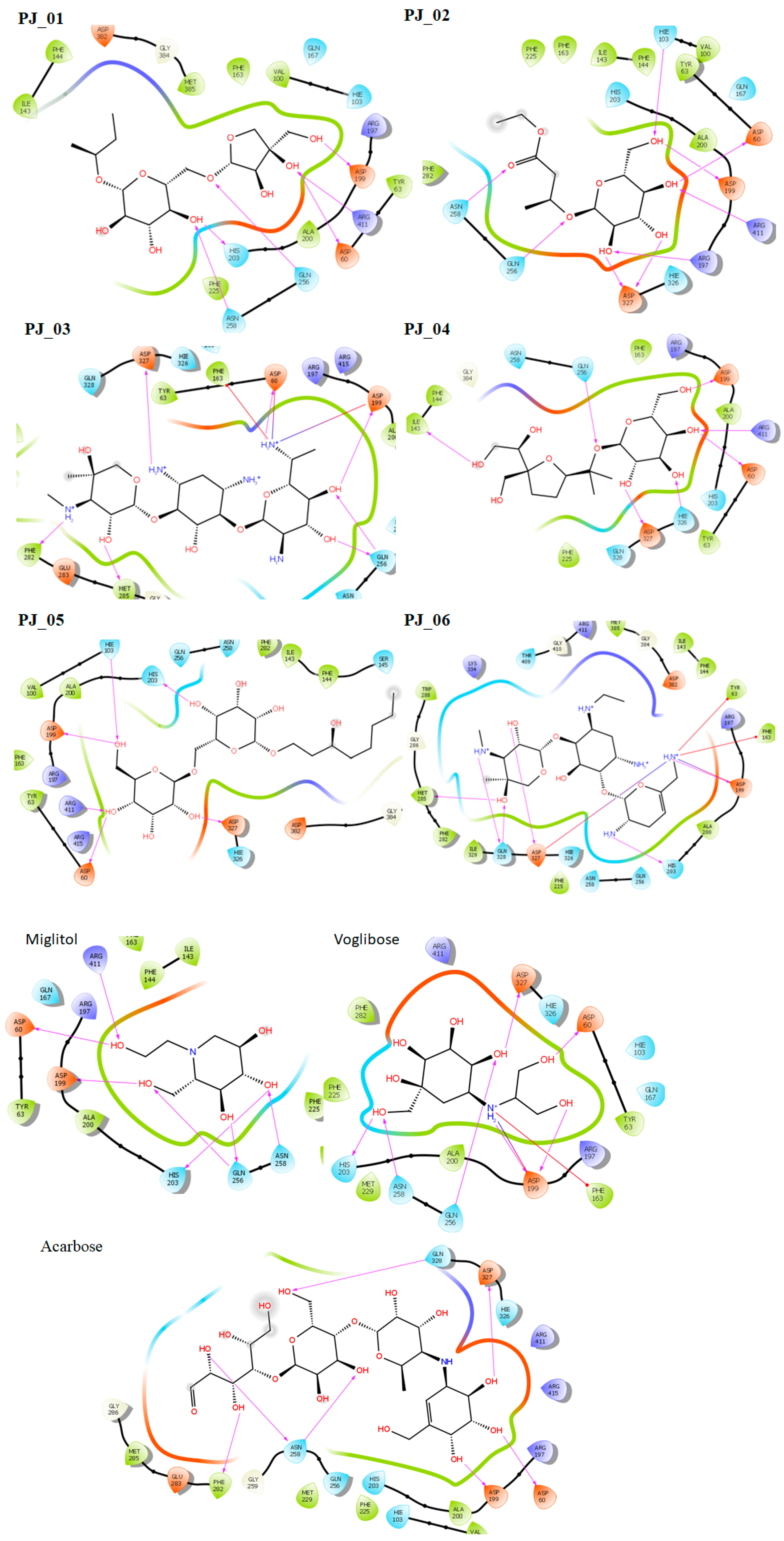
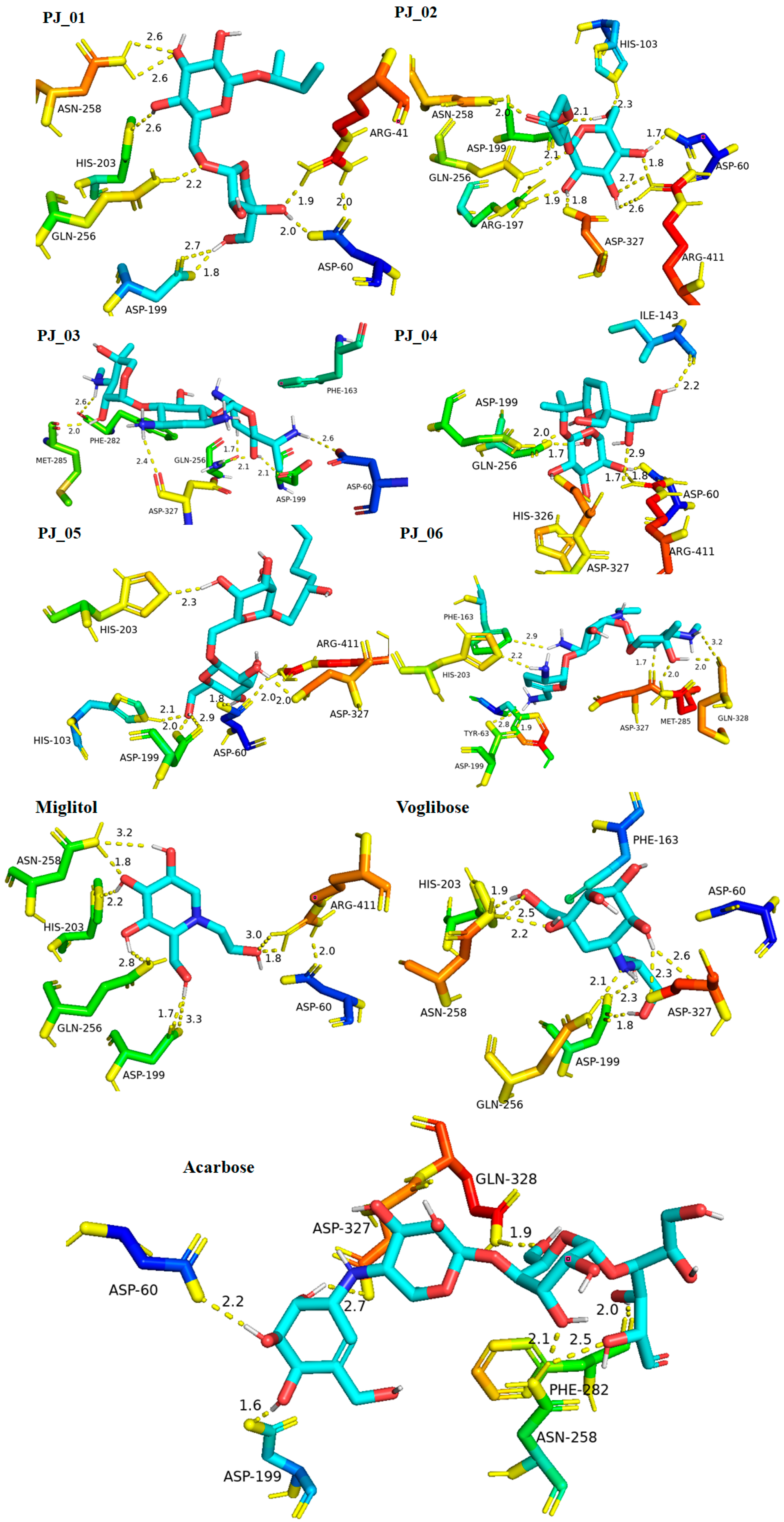
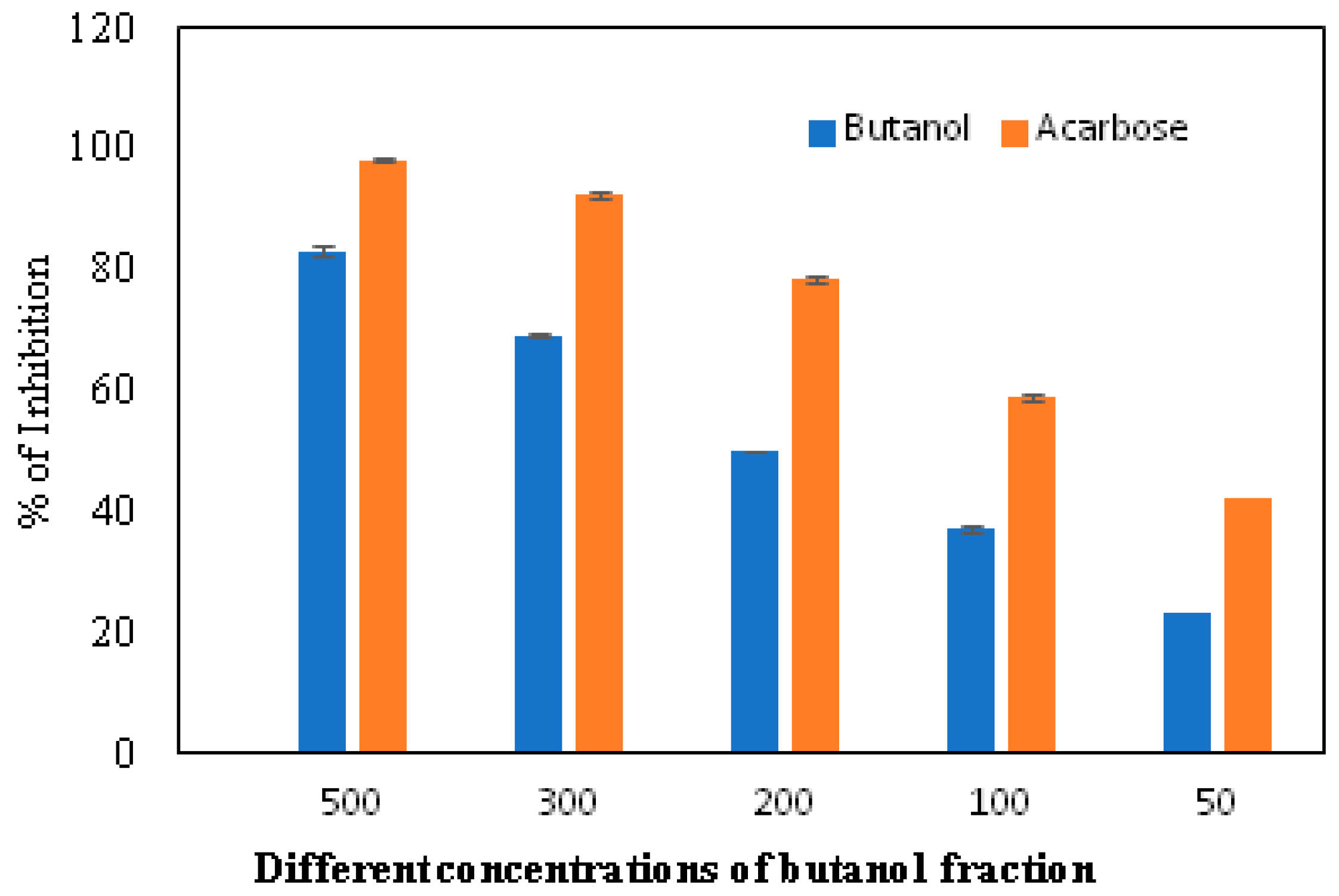

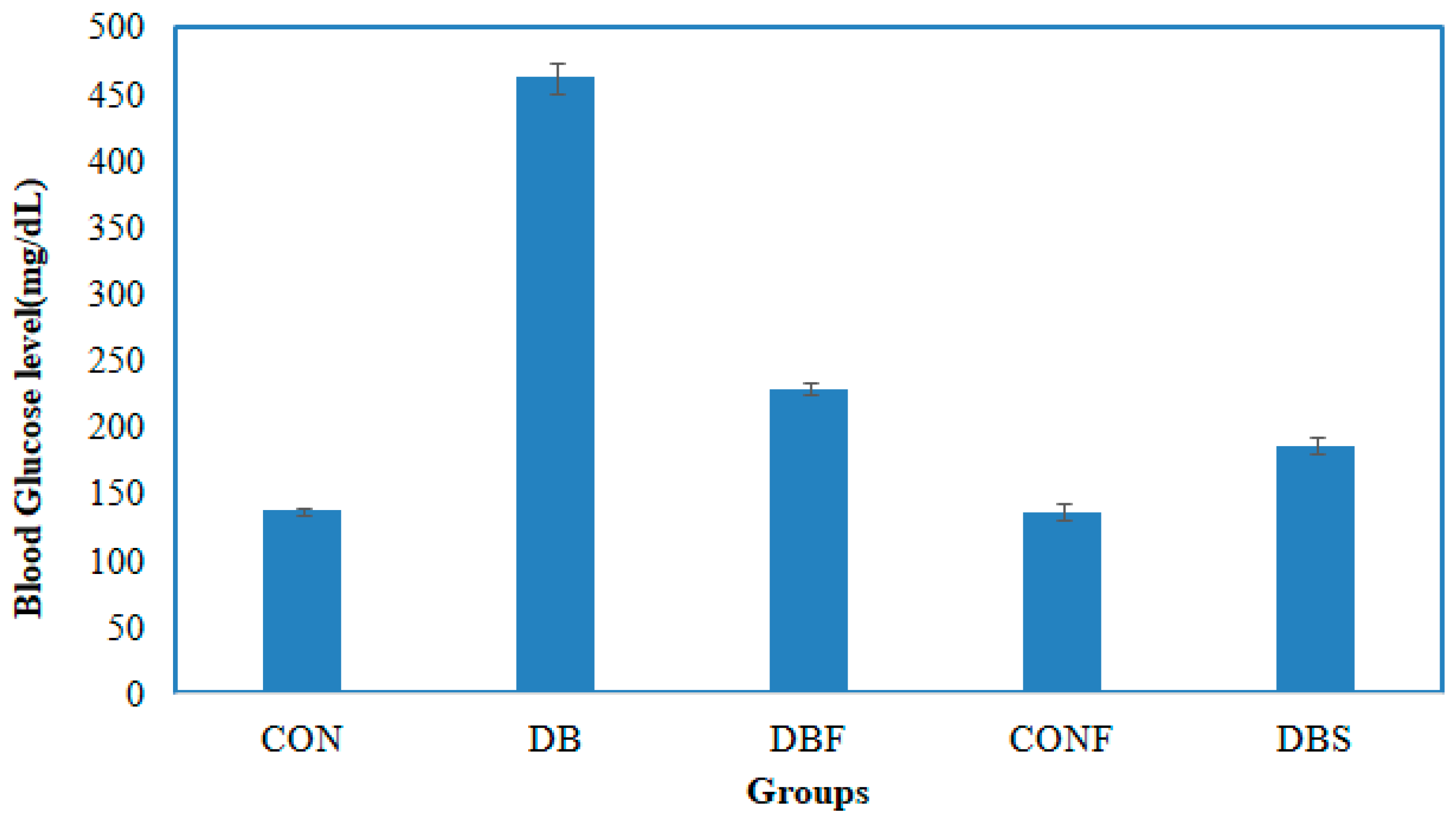
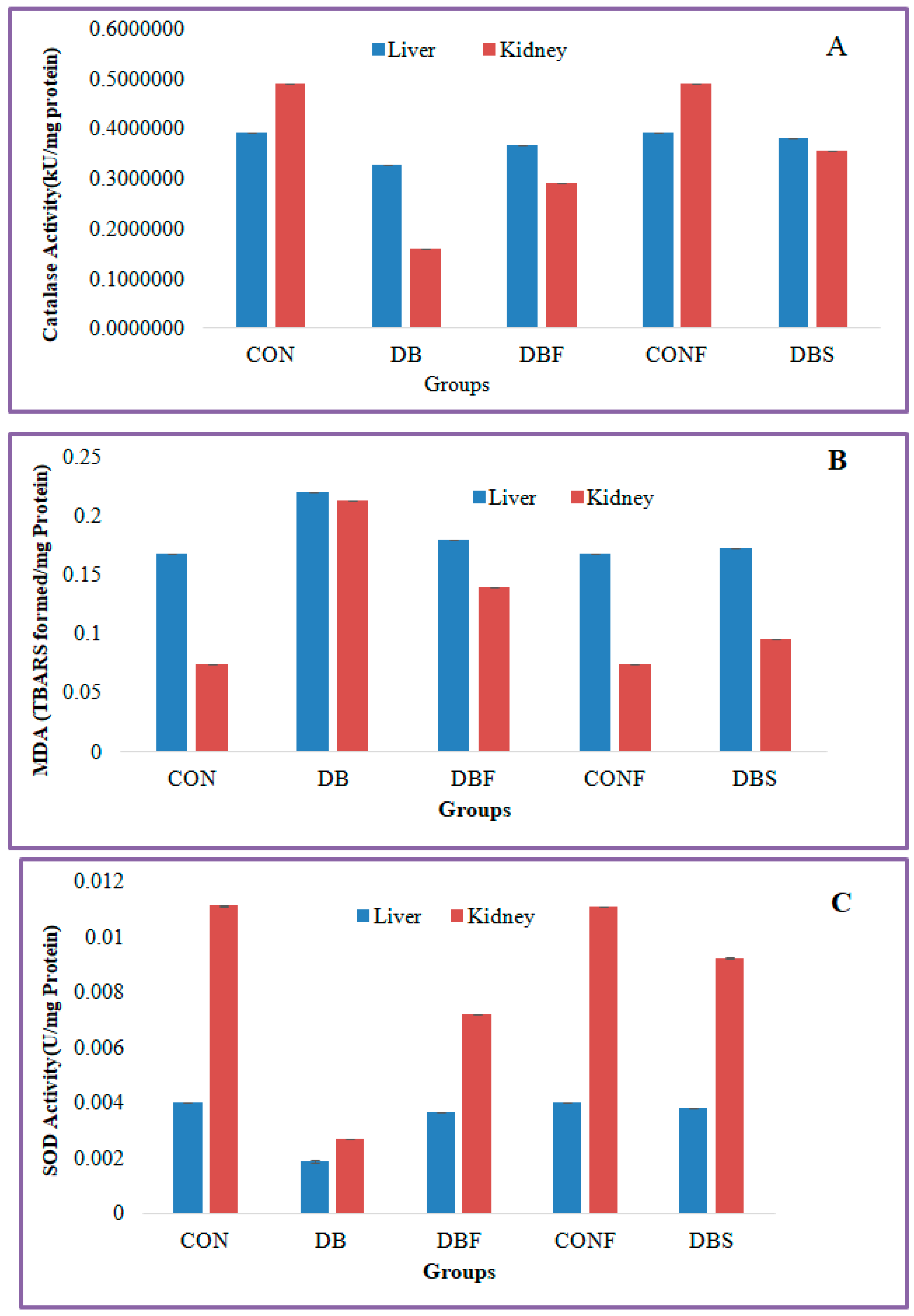

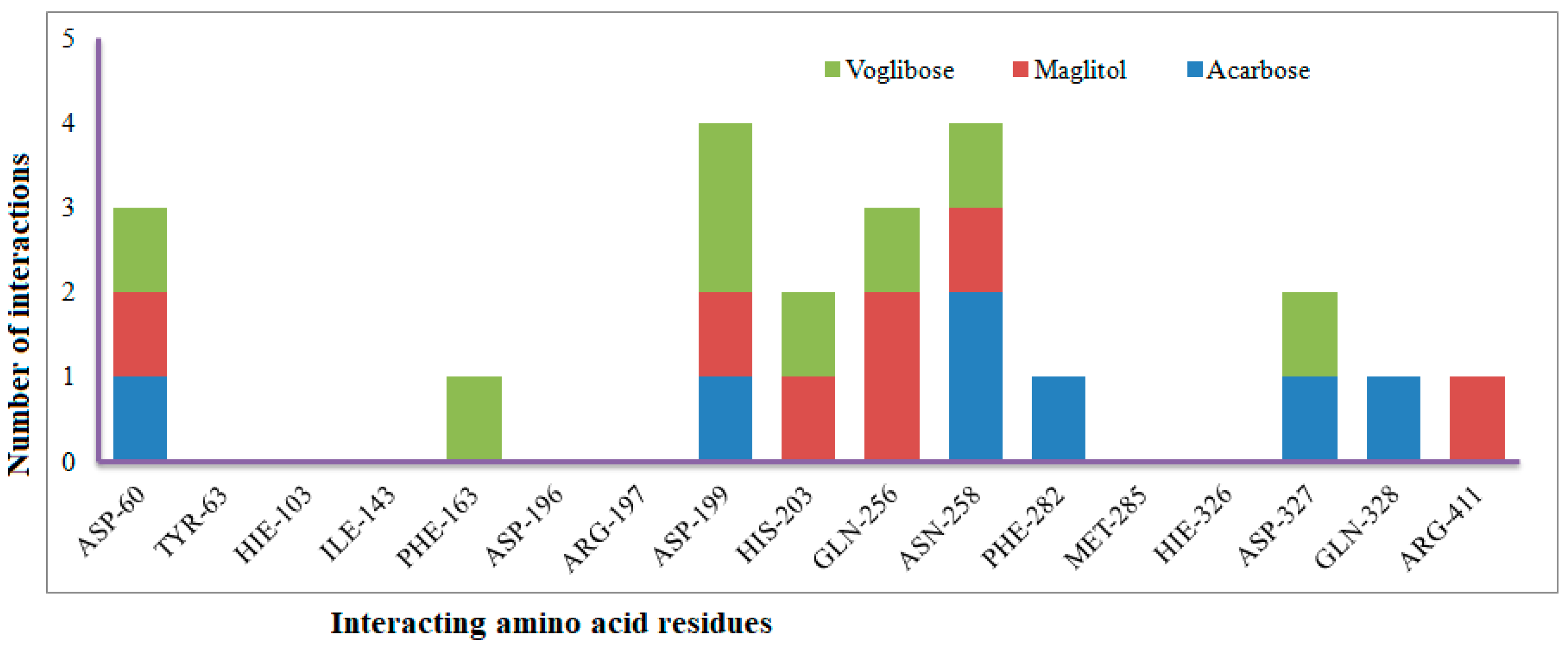

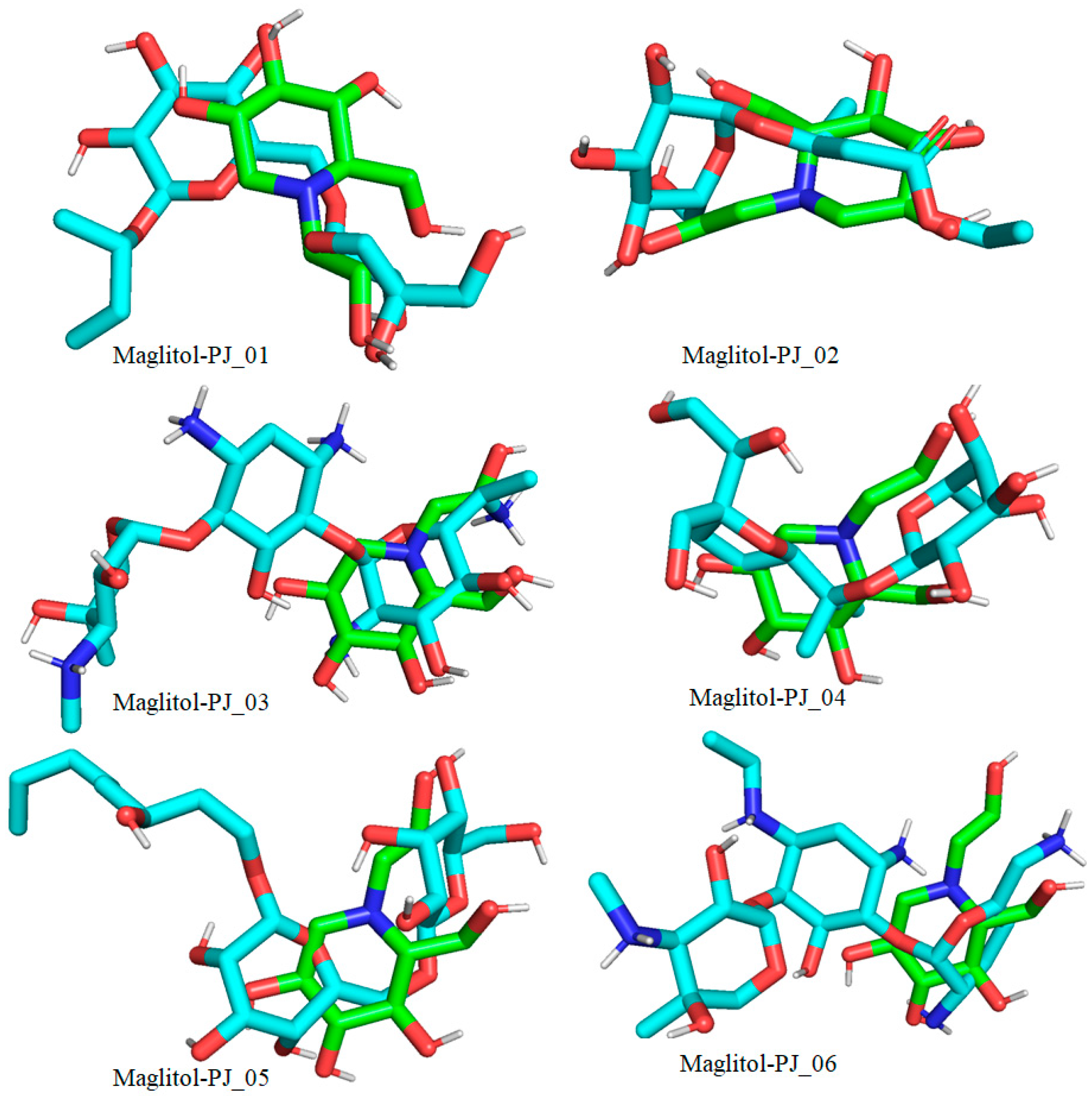
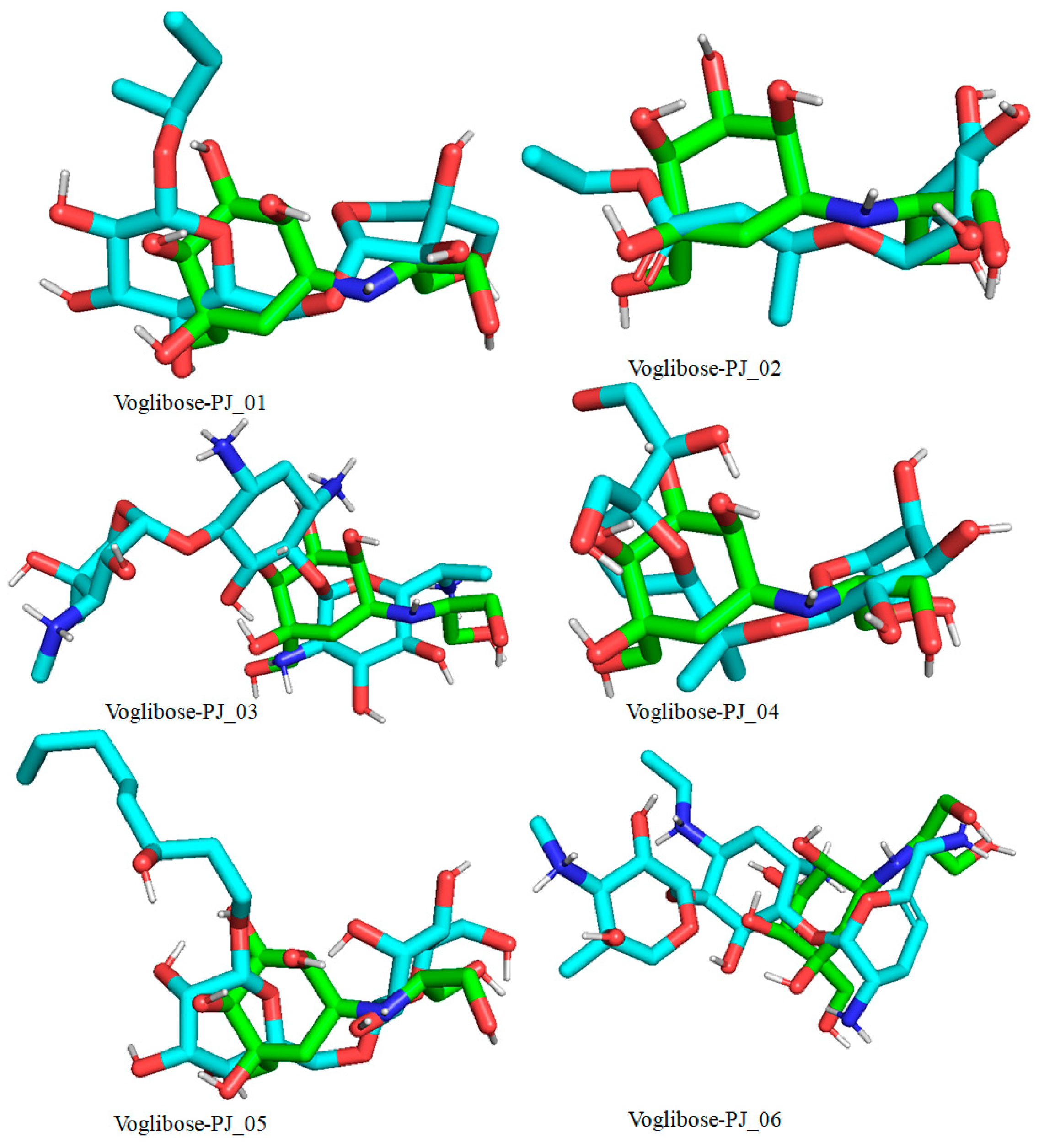
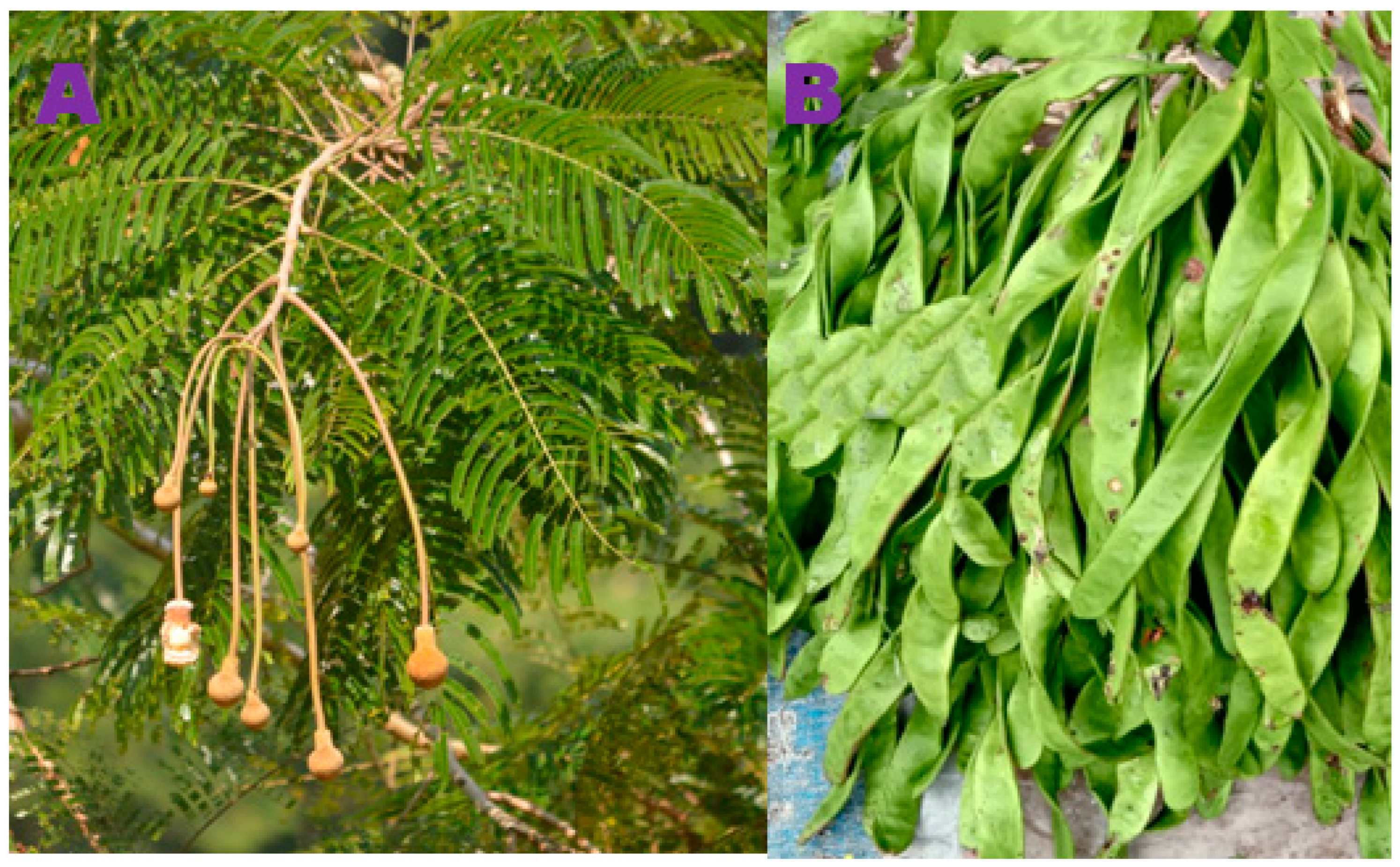
| Comp. | Name of Compound | Formula | RT | Mass | Molecular Ion | Exp. (m/z) | Score |
|---|---|---|---|---|---|---|---|
| PJ_01 | (2S)-2-butanol-O-[β-d-apiofuranosyl-(1→6)-β-d-glucopyranoside] | C15H28O10 | 6.405 | 368.1672 | [M+H]+ | 369.1750 | 95.14 |
| PJ_02 | Ethyl (S)-3-Hydroxylbutyrate glucoside | C12H22O8 | 6.584 | 294.1308 | [M+Na]+ | 317.1200 | 97.44 |
| PJ_03 | Antibiotic JI-20B | C20H41N5O9 | 7.532 | 495.2907 | [M+Na]+ | 518.2798 | 95.52 |
| PJ_04 | 1,2,10-Trihydroxydihydro-translinalyl oxide 7-O-β-d-glucopyranoside | C16H30O10 | 7.657 | 382.1832 | [M+NH4]+ | 400.2170 | 97.13 |
| PJ_05 | (R)-1-O-[β-d-glucopyranosyl-(1→6)-β-d-glucopyranoside]-1,3-octanediol | C20H38O12 | 8.369 | 470.2353 | [M+H]+ | 471.2427 | 96.93 |
| PJ_06 | Netilmicin | C21H41N5O7 | 11.513 | 475.3007 | [M+Na]+ | 498.2896 | 96.39 |
| PJ_07 | C16 Sphinganine | C16H35NO2 | 12.309 | 273.2661 | [M+H]+ | 274.2734 | 97.46 |
| PJ_08 | Pentanamide | C5H11NO | 12.762 | 101.0837 | [M+H]+ | 102.0910 | 95.12 |
| PJ_09 | Eudesmin | C22H26O6 | 14.079 | 386.1721 | [M+H]+ | 387.1795 | 97.68 |
| PJ_10 | Phytosphingosine | C18H39NO3 | 14.128 | 317.2924 | [M+H]+ | 318.2997 | 98.30 |
| PJ_11 | Nonadecanoic acid | C19H38O2 | 14.382 | 298.2866 | [M+NH4]+ | 316.3204 | 96.37 |
| PJ_12 | 1-Octadecanamine | C18H39N | 14.547 | 269.3077 | [M+H]+ | 270.3148 | 96.63 |
| PJ_13 | Oleamide | C18H35NO | 14.691 | 281.2712 | [M+H]+ | 282.2785 | 95.36 |
| PJ_14 | 1,2-Epoxyhexadecane | C16H32O | 15.163 | 240.2447 | [M+NH4]+ | 258.2785 | 97.28 |
| PJ_15 | Estra-1,3,5(10)-triene-3,6β,17β-triol triacetate | C24H30O6 | 15.721 | 414.2036 | [M+Na]+ | 237.1927 | 98.72 |
| PJ_16 | Militarinone A | C26H37NO6 | 15.722 | 459.2612 | [M+H]+ | 460.2684 | 97.35 |
| PJ_17 | Arachidic acid | C20H40O2 | 15.755 | 312.3020 | [M+NH4]+ | 330.3358 | 97.18 |
| PJ_18 | 4-Hydroxycoumarin | C9H6O3 | 15.994 | 162.0314 | [M+H]+ | 163.0386 | 97.35 |
| PJ_19 | 10-Eicosene | C20H40 | 16.352 | 280.3124 | [M+NH4]+ | 298.3462 | 96.63 |
| PJ_20 | Tetrahydropersin | C23H44O4 | 16.485 | 384.3232 | [M+NH4]+ | 402.3569 | 97.74 |
| PJ_21 | Rutamarin | C21H24O5 | 16.695 | 356.1617 | [M+Na]+ | 379.1510 | 97.78 |
| PJ_22 | Indicumenone | C15H24O3 | 16.885 | 252.1721 | [M+Na]+ | 275.1613 | 98.85 |
| PJ_23 | 2,6-вimethoxy-4-propylphenol | C11H16O3 | 16.885 | 196.109 | [M+H]+ | 197.1169 | 99.39 |
| PJ_24 | Orysastrobin | C18H25N5O5 | 17.190 | 391.1854 | [M+NH4]+ | 409.2192 | 96.30 |
| PJ_25 | Tetraneurin A | C17H22O6 | 17.376 | 322.1409 | [M+Na]+ | 345.1301 | 97.31 |
| PJ_26 | 2-Pentadecylfuran | C19H34O | 17.398 | 278.2604 | [M+NH4]+ | 296.2942 | 96.63 |
| PJ_27 | Docosanoic acid | C22H44O2 | 17.430 | 340.3334 | [M+NH4]+ | 358.3673 | 97.85 |
| PJ_28 | Dimethylbenzyl carbinyl hexanoate | C16H24O2 | 18.548 | 248.1773 | [M+H]+ | 249.1844 | 97.96 |
| PJ_29 | 7-Methoxy-2,2,4-trimethyl-3-(4- methoxyphenyl)-2H-1-benzopyran | C20 H22O3 | 18.867 | 310.1561 | [M+Na]+ | 333.1454 | 97.24 |
| PJ_30 | 3-Butylidene-7-hydroxyphthalide | C12H12O3 | 20.060 | 204.0783 | [M+H]+ | 205.0856 | 99.29 |
| PJ_31 | Diisobutyl phthalate | C16H22O4 | 20.060 | 278.1514 | [M+H]+ | 279.1585 | 99.27 |
| PJ_32 | 18-Oxooleate | C18H32O3 | 20.266 | 296.2344 | [M+H]+ | 297.2417 | 96.54 |
| PJ_33 | Decahydro-2-naphthoic acid | C11H18O2 | 20.267 | 182.1302 | [M+H]+ | 183.1375 | 98.69 |
| PJ_34 | (+)-12-(2-Cyclopenten-1-yl)-2-dodecanone | C17H30O | 20.271 | 250.2291 | [M+H]+ | 251.2363 | 97.87 |
| PJ_35 | 5β-gonane | C17H28 | 20.639 | 232.2188 | [M+H]+ | 233.2259 | 97.22 |
| PJ_36 | Gingerdione | C17H24O4 | 21.139 | 292.1668 | [M+Na]+ | 315.1560 | 95.61 |
| PJ_37 | 2,3-dihydroxycyclopentane-undecanoic acid | C16H30O4 | 21.686 | 286.2137 | [M+Na]+ | 309.2029 | 95.93 |
| PJ_38 | 1,3-Octadiene | C8H14 | 21.689 | 110.1093 | [M+H]+ | 111.1165 | 95.95 |
| PJ_39 | Acetyl tributyl citrate | C20H34O8 | 21.842 | 402.2246 | [M+Na]+ | 425.2138 | 97.76 |
| PJ_40 | Palmitic amide | C16H33 NO | 22.714 | 255.2555 | [M+H]+ | 256.2628 | 97.70 |
| PJ_41 | Drotaverine | C24H31NO4 | 22.916 | 397.2245 | [M+H]+ | 398.2318 | 98.23 |
| PJ_42 | Resolvin D2 | C22H32O5 | 23.433 | 376.2241 | [M+NH4]+ | 394.2579 | 97.29 |
| PJ_43 | Talatizamine | C24H39NO5 | 23.435 | 421.2819 | [M+H]+ | 422.2892 | 97.76 |
| PJ_44 | Bombykol | C16H30O | 23.490 | 238.2290 | [M+H]+ | 239.2363 | 98.05 |
| PJ_45 | 1-Monopalmitin | C19H38O4 | 23.492 | 330.2762 | [M+H]+ | 331.2835 | 96.82 |
| PJ_46 | Dubamine | C16H11NO2 | 23.587 | 249.078 | [M+H]+ | 250.0856 | 97.08 |
| PJ_47 | Tetrahydro-6-(2-hydroxy-16,19- dimethylhexacosyl)-4-methyl-2H-pyran-2-one | C34H66O3 | 24.854 | 522.4998 | [M+NH4]+ | 540.5337 | 95.73 |
| PJ_48 | Stearamide | C18H37NO | 25.150 | 283.2866 | [M+H]+ | 284.2939 | 95.51 |
| PJ_49 | Glycidyl stearate | C21H40O3 | 25.768 | 340.2969 | [M+H]+ | 341.3042 | 96.11 |
| PJ_50 | 2-Tetradecylcyclobutanone | C18H34O | 25.771 | 266.2604 | [M+H]+ | 267.2676 | 97.67 |
| PJ_51 | 4,4′-Diapophytoene | C30H48 | 28.099 | 408.3746 | [M+NH4]+ | 426.4084 | 96.41 |
| PJ_52 | Bis(4-methoxybenzoyl)-3a,29-dihydroxy-8-multifloren-7-one | C46H60O7 | 29.572 | 724.4353 | [M+H]+ | 725.4425 | 97.07 |
| PJ_53 | Pentalen-13-al | C15H22O | 32.372 | 218.1665 | [M+H]+ | 219.1738 | 98.19 |
| PJ_54 | 1-Octadecanamine | C18H39N | 32.465 | 269.3076 | [M+H]+ | 270.3149 | 97.94 |
| PJ_55 | Dexpanthenol | C9H19NO4 | 32.515 | 205.1308 | [M+Na]+ | 228.1200 | 97.87 |
| PJ_56 | Capsi-amide | C17H35NO | 32.598 | 269.2712 | [M+H]+ | 270.2785 | 96.54 |
| Comp. | Name of Compound | Formula | RT | Mass | Molecular Ion | m/z | Score |
|---|---|---|---|---|---|---|---|
| PJ_57 | 8-Demethyltetracenomycin C | C22H18O11 | 5.630 | 458.0846 | [M−H]− | 457.0772 | 99.05 |
| PJ_58 | Tecostanine | C11H21NO | 11.216 | 183.1620 | [M+CH3COO]− | 242.1759 | 99.10 |
| PJ_59 | 2-ethoxy-5-(1-propenyl)-phenol | C11H14O2 | 12.314 | 178.0993 | [M−H]− | 177.0920 | 98.11 |
| PJ_60 | 2,3-Dihydro-3-hydroxy-6-methoxy-2,2-dimethyl-4H-1-benzopyran-4-one | C12H14O4 | 12.315 | 222.0891 | [M−H]− | 221.0818 | 99.85 |
| PJ_61 | Tropolone | C7H6O2 | 12.315 | 122.0367 | [2M+Cl]− | 279.0403 | 99.95 |
| PJ_62 | (±)-1,4-nonanediol diacetate | C13H24O4 | 13.236 | 244.1672 | [M−H]− | 243.1599 | 97.65 |
| PJ_63 | 9,10-dihydroxy stearic acid | C18H36O4 | 16.578 | 316.2611 | [M−H]− | 315.2538 | 98.99 |
| PJ_64 | 3-hydroxyestra-1,3,5(10)-trien-16-one | C18H22O2 | 17.965 | 270.1618 | [M−H]− | 269.1545 | 98.53 |
| PJ_65 | 18-hydroxy-9Z-octadecenoic acid | C18H34O3 | 19.040 | 298.2505 | [M−H]− | 297.2433 | 98.44 |
| PJ_66 | Lauric acid | C12H24O2 | 19.792 | 200.1774 | [M−H]− | 199.1701 | 97.13 |
| PJ_67 | Lauryl hydrogen sulfate | C12H26O4S | 20.253 | 266.1548 | [M−H]− | 265.1476 | 97.22 |
| PJ_68 | (R)-10-hydroxystearic acid | C18H36O3 | 20.265 | 300.2661 | [M−H]− | 299.2588 | 98.44 |
| PJ_69 | Hexestrol monomethyl ether | C19H24O2 | 20.362 | 284.1773 | [M−H]− | 283.1700 | 98.83 |
| PJ_70 | 16-Hydroxy hexadecanoic acid | C16H32O3 | 22.198 | 272.2348 | [M−H]− | 271.2276 | 97.29 |
| PJ_71 | Myristic acid | C14H28O2 | 22.458 | 228.2088 | [M−H]− | 227.2015 | 98.77 |
| PJ_72 | 12α-methylpregna-4,9(11)-diene-3,20-dione | C22H30O2 | 22.529 | 326.2241 | [M−H]− | 325.2169 | 97.98 |
| PJ_73 * | 9α-(3-Methyl-2E-butenoyloxy)-4S-hydroxy-10(14)-oplopen-3-one 4-acetate | C22H32O5 | 23.341 | 376.2246 | [M−H]− | 375.2173 | 98.56 |
| PJ_74 | 4,8,12-trimethyltridecanoic acid | C16H32O2 | 24.773 | 256.2400 | [M−H]− | 255.2328 | 99.81 |
| PJ_75 | 11-cycloheptylundecanoic acid | C18H34O2 | 25.196 | 282.2558 | [M−H]− | 281.2484 | 98.13 |
| PJ_76 | Nonyl octanoate | C17H34O2 | 25.472 | 270.2556 | [M−H]− | 269.2484 | 98.27 |
| PJ_77 | Tetradecyl sulfate | C14 H30 O4S | 26.072 | 294.1862 | [M+CH3COO]− | 353.2002 | 97.62 |
| PJ_78 | Docusate | C20H38O7 S | 26.425 | 422.2335 | [M−H]− | 421.2262 | 95.97 |
| PJ_79 | Stearic acid | C18 H36O2 | 26.671 | 284.2715 | [M−H]− | 283.2642 | 98.24 |
| Compound Number | XPGS | MMGBSA dG Bind | Interacting Amino Acid Residues |
|---|---|---|---|
| PJ_01 | −9.092 | −26.259 | H-bonding: ASP-60, ASP-199, HIS-203, GLN-256, ASN-258, and ARG-411 |
| PJ_02 | −8.579 | −36.846 | H-bonding: ASP-60, HIE-103, ARG-197, ASP-199, GLN-256, ASN-258, ASP-327 (2), and ARG-411 |
| PJ_03 | −13.632 | −57.542 | H-bonding: ASP-60, ASP-199, GLN-256 (2), PHE-282, MET-285, and ASP-327 Π-cation: PHE-163 Salt bridge: ASP-60 and ASP-199 |
| PJ_04 | −10.506 | −27.704 | H-bonding: ASP-60, ILE-143, ASP-196, GLN-256, ASP-326, ASP-327, and ARG-411 |
| PJ_05 | −11.013 | −22.205 | H-bonding: ASP-60, HIE-103, ASP-199, HIS-203, ASP-327, and ARG-411 |
| PJ_06 | −13.818 | −80.784 | H-bonding: ASP-199, HIS-203, MET-285, ASP-327, and GLN-328 Π-cation: TYR-63 and PHE-163 Salt bridge: ASP-327 |
| Maglitol | −7.327 | −22.722 | H-bonding: ASP-60, ASP-199, HIE-203, GLN-256 (2), ASN-258, and ARG-411 |
| Voglibose | −8.662 | −32.823 | H-bonding: ASP-60, ASP-199, HIS-203, GLN-256, ASN-258, and ASP-327 Π-cation: PHE-163 Salt bridge: ASP-199 |
| Acarbose | −11.975 | −54.124 | H-bonding: ASP-60, ASP-199, ASN-258, PHE-282, ASP-327, and GLN-328 |
| Fraction | % of α-Glucosidase Inhibition | IC50 (µg/mL) | ||||
|---|---|---|---|---|---|---|
| 50 (µg/mL) | 100 (µg/mL) | 200 (µg/mL) | 300 (µg/mL) | 500 (µg/mL) | ||
| Butanol | 23.31±0.51 | 37.38 ± 0.20 | 50.11 ± 0.34 | 69.23 ± 0.73 | 83.21 ± 0.21 | 261.9 |
| Acarbose | 42.15 ± 0.36 | 59.02 ± 0.60 | 78.34 ± 0.37 | 92.48 ± 0.50 | 98.31 ± 0.35 | 95.98 |
| Sl.No | Channel | Ch.1 Solvent | Name 1 | Used | Percent |
|---|---|---|---|---|---|
| 1 | A | 100.0% Water V.03 | 0.1% Formic acid | Yes | 95.0 |
| 2 | B | 100.0% Acetonitrile V.03 | - | Yes | 5.0 |
| Sl.No | Time (min) | A (%) | B (%) | C (%) | D (%) | Flow (mL/min) | Pressure (Bar) |
|---|---|---|---|---|---|---|---|
| 1 | Start. cond | 95.0 | 5.0 | 0.0 | 0.0 | 0.30 | 1300.0 |
| 2 | 25.00 | 0.0 | 100.0 | 0.0 | 0.0 | 0.30 | 1300.0 |
| 3 | 30.00 | 0.0 | 100.0 | 0.0 | 0.0 | 0.30 | 1300.0 |
| 4 | 31.00 | 95.0 | 5.0 | 0.0 | 0.0 | 0.30 | 1300.0 |
| 5 | 35.00 | 95.0 | 5.0 | 0.0 | 0.0 | 0.30 | 1300.0 |
Disclaimer/Publisher’s Note: The statements, opinions and data contained in all publications are solely those of the individual author(s) and contributor(s) and not of MDPI and/or the editor(s). MDPI and/or the editor(s) disclaim responsibility for any injury to people or property resulting from any ideas, methods, instructions or products referred to in the content. |
© 2024 by the authors. Licensee MDPI, Basel, Switzerland. This article is an open access article distributed under the terms and conditions of the Creative Commons Attribution (CC BY) license (https://creativecommons.org/licenses/by/4.0/).
Share and Cite
Sarkar, A.; Chakrabarti, A.; Bhaumik, S.; Debnath, B.; Singh, S.S.; Ghosh, R.; Zaki, M.E.A.; Al-Hussain, S.A.; Debnath, S. Parkia javanica Edible Pods Reveal Potential as an Anti-Diabetic Agent: UHPLC-QTOF-MS/MS-Based Chemical Profiling, In Silico, In Vitro, In Vivo, and Oxidative Stress Studies. Pharmaceuticals 2024, 17, 968. https://doi.org/10.3390/ph17070968
Sarkar A, Chakrabarti A, Bhaumik S, Debnath B, Singh SS, Ghosh R, Zaki MEA, Al-Hussain SA, Debnath S. Parkia javanica Edible Pods Reveal Potential as an Anti-Diabetic Agent: UHPLC-QTOF-MS/MS-Based Chemical Profiling, In Silico, In Vitro, In Vivo, and Oxidative Stress Studies. Pharmaceuticals. 2024; 17(7):968. https://doi.org/10.3390/ph17070968
Chicago/Turabian StyleSarkar, Alekhya, Arjita Chakrabarti, Samhita Bhaumik, Bimal Debnath, Shiv Shankar Singh, Rajat Ghosh, Magdi E. A. Zaki, Sami A. Al-Hussain, and Sudhan Debnath. 2024. "Parkia javanica Edible Pods Reveal Potential as an Anti-Diabetic Agent: UHPLC-QTOF-MS/MS-Based Chemical Profiling, In Silico, In Vitro, In Vivo, and Oxidative Stress Studies" Pharmaceuticals 17, no. 7: 968. https://doi.org/10.3390/ph17070968





